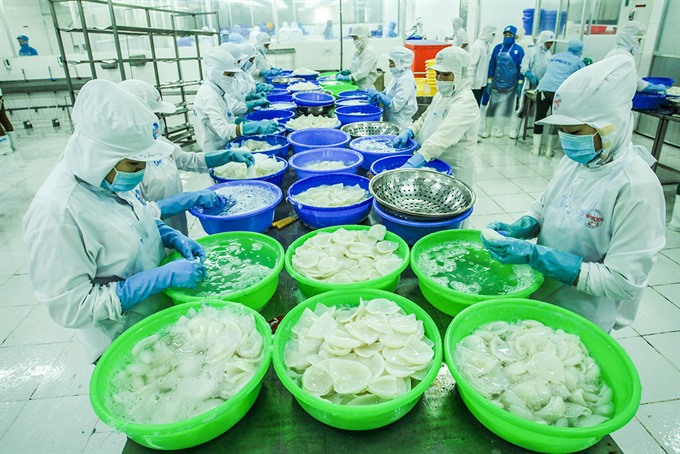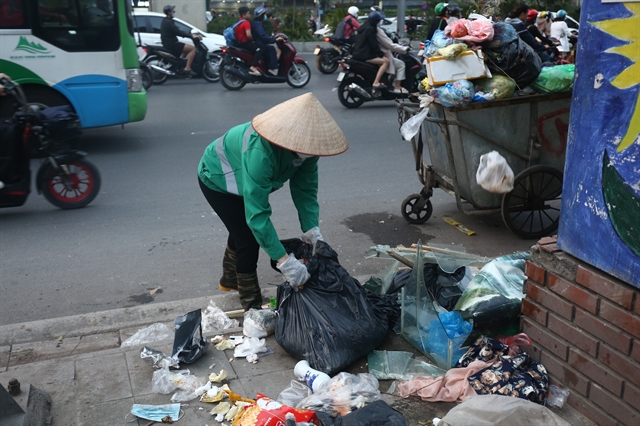 Economy
Economy

Việt Nam will continue to renew the growth model and enhance growth quality to improve economic productivity and competitiveness, stated a Party resolution issued in Hà Nội on Tuesday.
 |
| Work in progress at the Ngô Quyền Processing Export Joint Stock Company in the Mekong Delta’s Kiên Giang Province. A new Party Resolution adopted on Tuesday calls for completing mechanisms for SOE equitisation. — VNA/VNS Photo Trọng Đạt |
HÀ NỘI — Việt Nam will continue to renew the growth model and enhance growth quality to improve economic productivity and competitiveness, stated a Party resolution issued in Hà Nội on Tuesday.
Party General Secretary Nguyễn Phú Trọng signed Resolution No 05-NQ/TW during the fourth plenum of the 12th Party Central Committee, which aims at fast, sustained and comprehensive development for the national economy, society and environment.
The resolution said the country will maintain inflation rates below 5 per cent per year and reduce State budget overspending rates to less than 4 per cent of gross domestic product (GDP) by 2020, and about 3 per cent of GDP by 2030.
The resolution aims to keep public debt below 65 per cent of GDP from 2016-20, with Government debt reaching no more than 55 per cent of GDP and foreign debt hitting 50 per cent of GDP at most.
These caps drop to 60 per cent, 50 per cent and 45 per cent, respectively, by 2030.
About 30-35 per cent of nationwide enterprises are hoped to have creative and innovative activities, and average growth in labour productivity is aimed at more than 5.5 per cent per year over the next five years.
By 2020, the ratio of workers with training certificates is expected to reach 25 per cent, and the ratio of agricultural labourers to fall below 40 per cent.
Total-factor productivity (TFP), which accounts for effects in total output growth relative to growth in traditional measures of labour and capital, is set to contribute 30-35 per cent to economic growth during 2016-20.
This will help Việt Nam narrow the gap in competitiveness with ASEAN-4 countries, which include Indonesia, Malaysia, the Philippines and Thailand.
The resolution states that Việt Nam will not chase growth at any cost.
The country aims to exploit its resources effectively, while trying to take advantage of scientific and technological advancements.
The country considers deep growth an important part of development. Instead of relying solely on investment and exports, Viet Nam aims to grow through the domestic market.
The strategic priorities for economic reforms are: completing the institutions of a socialist-oriented market economy, ensuring macro-economic stability, improving the business and investment climate and enhancing human resources quality.
Other top priorities include rationalising agriculture in concert with building new-style rural areas, and restructuring public investments, State-owned enterprises (SOEs) and the credit institution system.
The State budget, public debt and public non-productive units will also be reorganised.
‘Basically stable’
The report says that current macro-economic conditions are stable and the economy is growing reasonably well.
The growth model, labour productivity and TFP, along with national competitiveness and structure of the economy are progressing well. Infrastructure, human resources and science and technology have been improved.
Ssecurity in financial restructuring has been assured, with no collapses in banking reorganisation. Bad debts and fragile credit institutions are being gradually handled.
Many SOEs have been equitised and massive public investments curbed.
Agriculture is showing stable development with new production modes, and industrial production is recovering.
International integration has been sped up, with the signing of new-generation free trade agreements (FTAs) such as the Trans-Pacific Partnership and European Union – Việt Nam FTA.
However, the country’s renewal of the growth model is slow, the resolution says.
Economic growth still mainly relies on increasing investment capital and large workforces, both factors that are slowing.
Macro-economic factors remain uncertain, with budget overspending high, public debt expanding rapidly and Government debt crossing the red line.
Completing the socialist-oriented market economy has been slow and obstacles hamper improving the business and investment environment. The quality of human resources remains low and there is a lack of modern infrastructure.
There are few proper connections between economic restructuring and growth model renewal, as well as between investment reorganisation and budget rationalisation and public debt security.
Bad debts remain high, and many SOEs still need to be equitised.
Agricultural production activities are mostly small-scale with few investments and little linkages between processing and distribution. Restructuring manufacturing, construction and service areas is still ineffective.
Many localities fail to exploit their competitive edges fully or co-ordinate with other areas and some key economic regions are unable to drive regional development.
Inadequate awareness among authorities, businesses and society about growth model renewal, and the existence of “privileged groups”, are among reasons for the shortcomings, the resolution said.
Strategic priorities
The resolution says Việt Nam will strive for more effective macro-economic operations, while continuing to perform strategic priorities.
The country will complete the mechanism for SOEs equitisation, balance development between capital and monetary markets, and share and bond markets, as well as State bonds and corporate bonds, and credit and non-credit services.
It will pay more attention to developing venture capital and consumer credit markets, and upgrade public investment management in line with international practices.
The country will speed up administrative reforms to improve business confidence, create advantageous conditions for start-ups and business innovators, and boost connections between foreign and domestic economic sectors.
It will continue to complete legal frameworks on land, labour and the environment.
Việt Nam will accelerate investments through public-private partnerships, and concentrate public investment on core infrastructure projects in key economic regions. It will develop some special administrative – economic zones, and smart cities.
It will attach importance to education and training and science and technology development to create international-level human resources.
With technology transfer an essential factor for enhancing productivity, quality and competitiveness of the economy, the country will hasten the development of industrial and hi-tech zones and build proper policies for technology imports.
The country will intensify supervision of SOEs’ use of loans, and handle those suffering losses or with inefficient investments. It will tackle “cross-ownership” among credit institutions and issue regulations to deal with bad debts.
It will step up fights against corruption for the more effective management of the State budget, public debt and public investments.
The country also aims to produce environmentally-friendly agriculture with hi-tech applications, trying to build brand names for local farm produce, and modernise rural infrastructure to cope with climate change.
It will boost the development of manufacturing and processing industries, especially spare parts industries to better take part in global value chains.
Regarding services, areas with potential include banking and finance, maritime and logistics, oil and gas, aviation, healthcare, auditing and consultancy. Tourism is expected to become an economic spearhead of the nation by 2020.
The resolution also says the private economic sector must drive economic development, and connections among localities and regions are needed.
Enhancement of State management efficiency and guaranteeing national defense and security are vital in economic development, it says. — VNS




